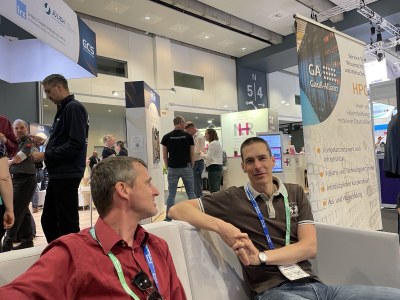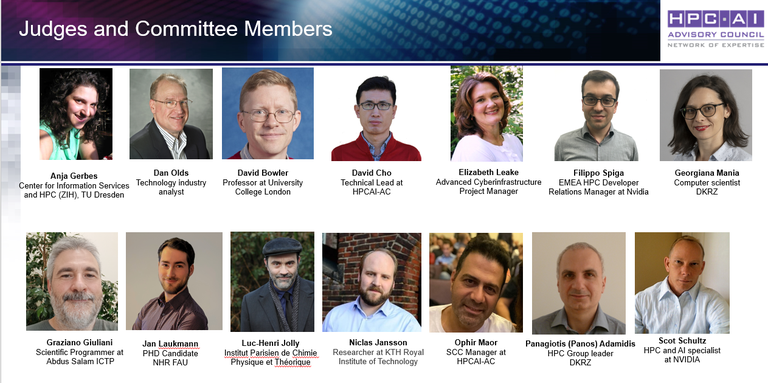15.05.2024
The Frontier system at the Oak Ridge National Laboratory remains in first place in the TOP500 in the USA with a performance of 1.206 ExaFlop/s. Behind it, the Aurora system from the Argonne Leadership Computing Facility, USA, secured second place as the second official exascale system in the world, although the final expansion has not yet been achieved. As the most powerful European system, LUMI comes in 5th place at the CSC in Finland with 380 PetaFlop/s.
Around 100 national and international exhibitors were present at the ISC. At the booth No. K20 of the Gauß-Allianz (GA), Hendryk Bockelmann and Jan Fredrik Engels presented current findings of the DKRZ team at the sofa talks: On May 14 at 1 p.m., they spoke on the topic of GreenHPC in climate research using the EECliPs and EE-HPC projects as examples. On May 15th at 2 p.m. they showed how the weather and climate model ICON, recently published as open source, is being further developed for exascale systems. Visualizations of current, high-resolution climate modeling have been displayed at the GA booth.
Johannes Meuer participated in the scientific conference program with a scientific poster „Auto-Regressive Generative Deep Learning Approach Towards Creating High-Resolution Climate Simulations“ on machine learning methods and their use in climate research.
In the project poster session, Joachim Biercamp presented the efforts of the Center of Excellence for Weather and Climate Research in Europe with the contribution “ESiWACE — Towards Exascale Weather and Climate Simulations”.
All posters were displayed in the Foyer D-G (2nd floor of the CCH) until May 15th at 4 p.m. On May 16, 2024, Georgiana Mania was invited as a speaker at “The Fifth Workshop on LLVM Compiler and Tools for HPC” and reported under the title “ICON meets the LLVM compilers” how they were used for ICON and what performance they achieved compared to other compilers. The compiler flang was used for the Fortran programming of ICON as a whole and clang was used for programming the ICON microphysics in the C++ language.
This year, the DKRZ once again contributed to the successful implementation of the Student Cluster Competition (SCC), particularly in the programming part (Coding Challenge) of the online competition. The DKRZ team created a sequential version of cloud microphysics for the weather and climate model ICON in the C++ programming language. During the SCC the teams have to port this to GPUs, with half of the SCC teams using OpenMP and the others using OpenACC. A total of 17 teams submitted their results. The best results of the coding challenge were delivered by the student team from Sun Yat-Sen University/China for OpenMP and the team from North Carolina State University/USA for OpenACC. The codes developed will be incorporated into the further development of ICON (ICON Development Branch) and will for the first time be further used after the SSC. The members of the two teams are therefore listed by name as ICON developers.
At the SCC, Georgiana Mania and Panagiotis Adamidis represented the DKRZ as two of the fourteen-member jury committee and also support the implementation of the SCC. DKRZ also provided four GPU nodes on Levante for the coding challenge.

This year, a joint student team from the Otto von Guericke University of Magdeburg and the University of Hamburg took part in the on-site SCC competition at ISC'24 in Hamburg, being supported by Jannek Squar and Anna Fuchs from the “Scientific Computing” group at the DKRZ.
Article in HPC-Wire about the SCC: https://www.hpcwire.com/2024/05/16/isc-2024-student-cluster-competition/
